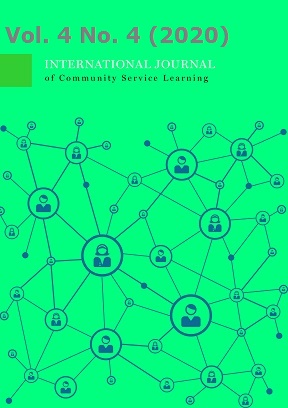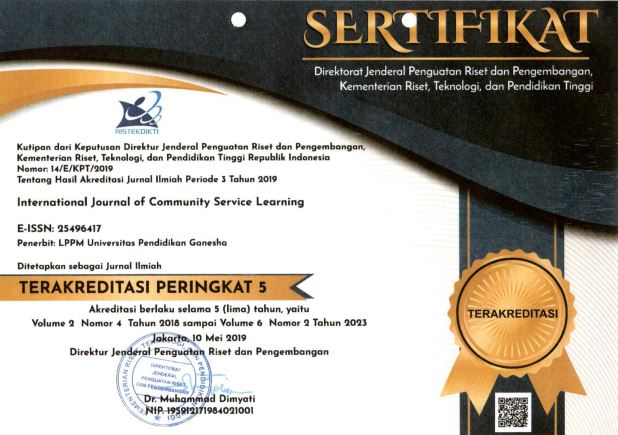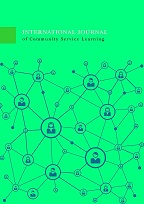You-Tube and Instagram Content Development: Community Service to Empower and Promote Society
DOI:
https://doi.org/10.23887/ijcsl.v4i4.29303Keywords:
Social Media, You-Tube, Instagram, Community Service, SocietyAbstract
The use of You-Tube and Instagram as Social Media is to inform the existence of Society. So, the role of society is to empower its potency and design content to promote the potency in order to be uploaded in those platforms. Community service program facilitates college students, as a part of society, to empower them and other members of society and create content based on its empowerment. The aim of the study is to describe the college students’ activities during their teaching on five programs (teaching English, Digital Content, Souvenirs, Local Culinary, and Healthy Lifestyle) in community service program as the content that would be uploaded in You-Tube and Instagram to promote Plesungan village. The subjects of the study are teenagers and mommies living at Plesungan village. The setting of the research is at Plesungan village, Karanganyar, Central Java, Indonesia. The research was carried out from 23 July 2020 up to 31 August 2020. The techniques in collecting the data are questionnaires, documentation (video recording and photograph), and observation. The technique analyzing the data used interactive analysis that contains data display, data reduction, and conclusion. Research findings show that the implementation of five training programs is successful viewed from the villagers’ participation and creativity, also the documentation in terms of videos and photos have been uploaded in The Instagram and You-Tube (the links attached).
References
Abu-Shakra, A. (2012). Including a service learning educational research project in a biology course-II: Assessing community awareness of legionnaires’ disease? European Journal of Educational Research, 1(3), 271–282. https://doi.org/10.12973/eu-jer.1.3.271
Amornpashara, N., Rompho, N., & Phadoongsitthi, M. (2015). A study of the relationship between using Instagram and purchase intention. Journal for Global Business Advancement, 8(3), 354–370. https://doi.org/10.1504/JGBA.2015.071330
Antonio, A. L., Astin, H. S., & Cress, C. M. (2000). Community Service in Higher Education : A Look at the Nation ’ s Faculty. The Review of Higher Education, 23(4), 373–397. https://doi.org/https://doi.org/10.1353/rhe.2000.0015
Bartel, C. A., Saavedra, R., & Dyne, L. V. A. N. (2001). Design conditions for learning in community service contexts. Journal of Organizational Behavior, 385(April), 367–385. https://doi.org/10.1002/job.90
Berthon, P. R., Pitt, L. F., Plangger, K., & Shapiro, D. (2012). Marketing meets Web 2.0, social media, and creative consumers: Implications for international marketing strategy. Business Horizons, 55(3), 261–271. https://doi.org/10.1016/j.bushor.2012.01.007
Bodorko, B., & Pataki, G. (2009). Linking academic and local knowledge : community-based research and service learning for sustainable rural development in Hungary. Journal of Cleaner Production Journal, 17, 1123–1131. https://doi.org/10.1016/j.jclepro.2009.02.023
Cox, J. R. (2011). Enhancing student interactions with the instructor and content using pen-based technology, youtube videos, and virtual conferencing. Biochemistry and Molecular Biology Education, 39(1), 4–9. https://doi.org/10.1002/bmb.20443
Crabtree, R. D. (2008). Theoretical Foundations for International Service-Learning. Michigan Journal OfCommunity Service Learning, 18–36. Retrieved from https://files.eric.ed.gov/fulltext/EJ831380.pdf
Dahnil, M. I., Marzuki, K. M., Langgat, J., & Fabeil, N. F. (2014). Factors Influencing SMEs Adoption of Social Media Marketing. Procedia - Social and Behavioral Sciences, 148, 119–126. https://doi.org/10.1016/j.sbspro.2014.07.025
Dehghani, M., Niaki, M. K., Ramezani, I., & Sali, R. (2016). Evaluating the influence of YouTube advertising for attraction of young customers. Computers in Human Behavior, 59, 165–172. https://doi.org/10.1016/j.chb.2016.01.037
Eppolito, A. M., Pelcher, S. B., & Wright, J. (1996). A College-Community Service Program to Improve Student Reading. Kappa Delta Pi Record, 32(4), 135–136. https://doi.org/10.1080/00228958.1996.10518672
Fatanti, M. N., & Suyadnya, I. W. (2015). Beyond User Gaze: How Instagram Creates Tourism Destination Brand? Procedia - Social and Behavioral Sciences, 211(September), 1089–1095. https://doi.org/10.1016/j.sbspro.2015.11.145
Haggard, J. L., Moore, G. W., Phillips, G. W., & Phillips, L. (2007). Journal of College & Character. Journal of College & Character, IX(2), 1–10.
Hanan, H., & Putit, N. (2013). Express marketing of tourism destinations using Instagram in social media networking. Hospitality and Tourism, 471–474. https://doi.org/10.1201/b16064-93
Haridakis, P., & Hanson, G. (2009). Social interaction and co-viewing with YouTube: Blending mass communication reception and social connection. Journal of Broadcasting and Electronic Media, 53(2), 317–335. https://doi.org/10.1080/08838150902908270
Holland, B. A. (2001). A Comprehensive Model for Assessing Service-Learning and Community- University Partnerships. In NEW DIRECTIONS FOR HIGHER EDUCATION (pp. 51–60). John Wiley & Sons, Inc.
Jones, S. R., & Hill, K. E. (2003). Understanding Patterns of Commitment : Student Motivation for Community Service Involvement. The Journal of Higher Education, 74(5), 516–539. https://doi.org/https://doi.org/10.1353/jhe.2003.0036 For
Kadama, M. (2002). Creating new businesses through a strategic innovation community — case study of a new interactive video service in Japan. International Journal of Project Management, 20, 289–302. https://doi.org/www.elsevier.com/locate/ijproman
Khalid, A., & Muhammad, K. (2012). The Use of YouTube in Teaching English Literature The Case of Al-Majma’ah Community College, Al-Majma’ah University (Case Study). International Journal of Linguistics, 4(4), 525–551. https://doi.org/10.5296/ijl.v4i4.2930
Kujur, F., & Singh, S. (2018). Emotions as predictor for consumer engagement in YouTube advertisement. Journal of Advances in Management Research, 15(2), 184–197. https://doi.org/10.1108/JAMR-05-2017-0065
Latiff, Z. A., & Safiee, N. A. S. (2015). New Business Set Up for Branding Strategies on Social Media - Instagram. Procedia Computer Science, 72, 13–23. https://doi.org/10.1016/j.procs.2015.12.100
Lee, D. Y., & Lehto, M. R. (2013). User acceptance of YouTube for procedural learning: An extension of the Technology Acceptance Model. Computers and Education, 61(1), 193–208. https://doi.org/10.1016/j.compedu.2012.10.001
Markus, G. B., Howard, J. P. F., & King, D. C. (1993). Educational Evaluation and Policy Analysis. Educational Evaluation and Policy Analysis, 15(4), 410–419. https://doi.org/10.3102/01623737015004410
Messner, M., Medina-Messner, V., & Guidry, J. (2016). Global health and social media: using Instagram and Twitter in an open online class for global service-learning projects. Communication Teacher, 30(4), 185–189. https://doi.org/10.1080/17404622.2016.1219042
Rhoads, R. A. (1998). In the Service of Citizenship : A Study of Student Involvement in Community Service In the Service of Citizenship. The Journal of Higher Educatio, 69(3), 277–297. Retrieved from http://digitalcommons.unomaha.edu/slcehighered/83%0AThis
Saxena, A., & Khanna, U. (2013). Advertising on Social Network Sites: A Structural Equation Modelling Approach. Vision: The Journal of Business Perspective, 17(1), 17–25. https://doi.org/10.1177/0972262912469560
Song, J., & Kim, Y. J. (2006). Social influence process in the acceptance of a virtual community service. Information Systems Frontiers, 8(3), 241–252. https://doi.org/10.1007/s10796-006-8782-0
Utami, M. M., Taufik, H., & Bhakti, W. N. (2019). Village Tourism : The Implementation Of Community- Based Tourism. In International Conference of Organizational Innovation (ICOI 2019) VILLAGE (Vol. 100, pp. 537–542). Atlantis Press. Retrieved from http://creativecommons.org/licenses/by-nc/4.0/
Vinerean, S., Cetina, I., Dumitrescu, L., & Tichindelean, M. (2013). The Effects of Social Media Marketing on Online Consumer Behavior. International Journal of Business and Management, 8(14), 66–79. https://doi.org/10.5539/ijbm.v8n14p66
Williams, D. R., & Driscoll, A. (1997). Connecting curriculum content with community service: Guidelines for facilitating student reflection. Journal of Public Service & Outreach, 2(1), 33–42.
Yavuz, O., & Arslan, A. (2018). Cooperative learning in acquisition of the english language skills. European Journal of Educational Research, 7(3), 591–600. https://doi.org/10.12973/eu-jer.7.3.591
Yuan, S., & Fei, Y. (2010). A synthesis of semantic social network and attraction theory for innovating community-based e-service. Expert Systems With Applications, 37(5), 3588–3597. https://doi.org/10.1016/j.eswa.2009.10.033
Downloads
Published
How to Cite
Issue
Section
License

International Journal of Comunnity Service Learning is licensed under a Creative Commons Attribution-ShareAlike 4.0 International License.













